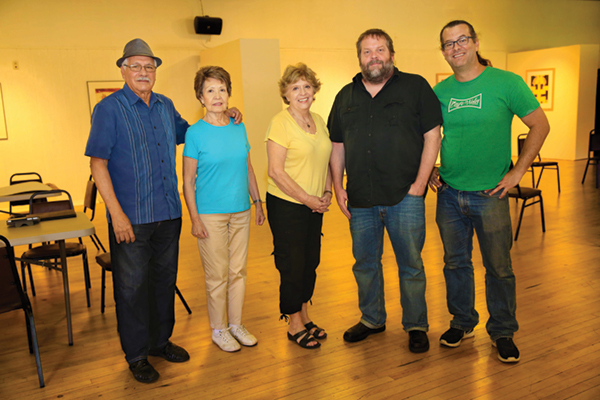[:en]
Making theater with and about community is a shared collaborative between L.A.’s Cornerstone Theater and Omaha’s Great Plains Theatre Conference. Cornerstone Theater Company artistic director Michael John Garces is cultivating South Omaha stories to inform a play he’s writing for next year’s GPTC PlayFest and its Neighborhood Tapestries series.
The playwright-director did a similar 2015 project for the Metropolitan Community College conference.
Cornerstone’s nationally recognized community engaged theater work led MCC theater instructor Scott Working, who helps coordinate the conference, to join the company’s summer institute. Working, a playwright-director, practiced Cornerstone methods. He said, “I learned how they engage with community, plumb the depths for stories and represent the community landscape in the design. I also learned a community isn’t necessarily geographical.”
Garces has immersed himself in ethnically diverse South Omaha. He moderated September story circles where people from different cultural communities shared their experiences. He’s holding more sessions in November. Eventually, professionals and nonprofessionals will share the stage in a fully produced work that collapses the wall between artist and audience. Bridging that disconnect led Garces to Cornerstone.
“The work gives us an opportunity as artists to be really connected to the people and the community in which we’re making theater. Hopefully we can make work that feels relevant to people’s lives in a way that’s fresh and exciting. I find that when it works it’s really satisfying.”
The raw material comes from people’s stories.
“Sometimes it’s as simple as sitting around and talking
and sometimes it’s more elaborate with exercises and things to get people talking and telling us about their lives,” Garces said. “I look for community members to provide the expertise about their community so I can write a play that hopefully accesses certain truths and things that feel authentic. My hope is to reflect the spirit of what’s going on in present-day South Omaha by capturing people’s voices and having some really firm grounding in the history.”
Garces has soaked up South Omaha.
“I took quite a few long walks going into restaurants and businesses and talking to people, eating food and hanging out. I tried to meet people in as many different contexts as possible. I find it to be a very colorful place in terms of the murals and the vivid contrasts of color and texture. I find the history and evolution of the various parish churches fascinating.
“Even as people have moved away, there’s clearly a very strong attachment to South Omaha. People’s attitudes seem to be, ‘Change is what happens here.’ While bittersweet, people are interested in what’s happening now and what’s going to happen.”
The project will go where people’s stories lead it but Working said there’s a focus on working families and entrepreneurs. He said participants such as Kris Jonyka and Ismara Gonzalez also referenced cultural identity issues across generations.
Jonyka was born in a post-World War II Displaced Persons camp in Germany. Her Lithuanian family settled in Omaha, where their life centered around St. Anthony’s parish. Her well-educated father worked in packing plants and construction before opening the family deli-bakery and later variety store featuring ethnic goods. At her folks’ urging, she obtained higher education and became a speech and debate educator. Along the way, she lost the thick accent that once caused her grief.
Gonzalez struggled going from Mexican village life to big city American life when her family immigrated here. She chafed at traditional roles she was expected to follow. Her mother did encourage her to pursue educational and entrepreneurial dreams. The competitive body builder and powerlifter owns Diamond Gym and California Produce. She plans publishing a magazine to promote health and nutrition among Latinos.
Though hailing from different circumstances, each family sought a better life and worked hard for it. Jonyka feels “a kinship” with South O’s immigrant-refugee-migrant populations. She liked growing up in South O’s mixed cultural stew. South O’s friendly vibe reminds Gonzalez of life back home in Mexico. Jonyka’s “eager to see” what Garces portrays. So is Gonzalez: “Yeah, I’m curious. I don’t put myself out there too much but if it helps, then I’m willing to share my story. I want to inspire other Latinas.”
The women may even wind up on stage. Garces said mixing non-professional and professional actors “creates a sort of alchemy that is very powerful,” adding, “When that chemistry really fires, it’s quite remarkable and exciting and it’s certainly what I love about the work we do.”
A public reading of his play will invite feedback before its 2017 Memorial Day weekend production.
Read more of Leo Adam Biga’s work at leoadambiga.com.[:]


